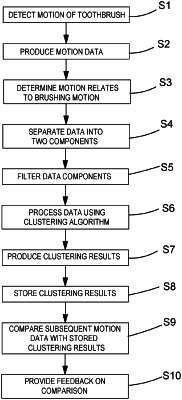| CPC G09B 19/0084 (2013.01) [A46B 9/04 (2013.01); A46B 15/0002 (2013.01); A46B 15/0006 (2013.01); A46B 15/0008 (2013.01); A46B 15/004 (2013.01); A46B 15/0046 (2013.01); G09B 19/0076 (2013.01); A46B 2200/1066 (2013.01)] | 20 Claims |

|
1. A device configured to provide an indication of brushing activity of a toothbrush, the device comprising:
an accelerometer configured to produce acceleration data from motion of the toothbrush, wherein the accelerometer is configured to produce the acceleration data in three orthogonal directions; and
a processor configured to:
receive the acceleration data;
extract gravitational components in three orthogonal directions from the acceleration data by low pass filtering the acceleration data to produce the gravitational components, wherein the gravitational components provide an indication of how the toothbrush is orientated;
calculate at least one angular coordinate from the gravitational components;
extract linear acceleration components in three orthogonal directions from the acceleration data by high pass filtering the acceleration data to produce the linear acceleration components;
average a magnitude of the linear acceleration components in the three orthogonal directions to produce an estimate of brushing dynamics, wherein the estimate of brushing dynamics is a scalar value that provides an indication of at least one of how strongly or how quickly a user is brushing teeth of the user;
project the gravitational components and the estimate of brushing dynamics into an n-dimensional space, where n≥2, wherein an angular coordinate of an n-dimensional vector in the n-dimensional space is the at least one angular coordinate calculated from the gravitational components of the acceleration data, and a radial coordinate of the n-dimensional vector in the n-dimensional space is the estimate of brushing dynamics;
perform a clustering process on a plurality of n-dimensional vectors formed by projecting subsequent gravitational components and estimates of brushing dynamics into the n-dimensional space to produce clustering results, the clustering results comprising a plurality of clusters each of which represents one brushing area; and
determine a brushing area based on an assignment of subsequent gravitational components and estimates of brushing dynamics projected into the n-dimensional space to a particular cluster; and
a feedback module configured to provide feedback to the user based on the determination of brushing area, thereby providing an indication of brushing activity.
|